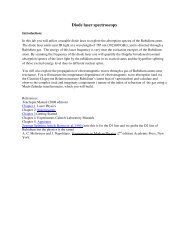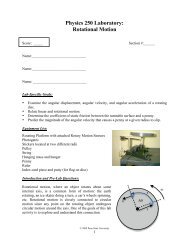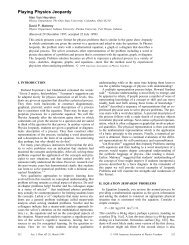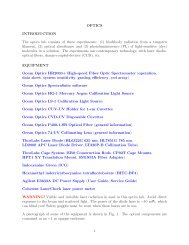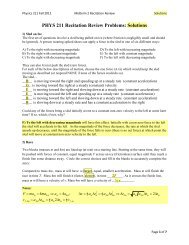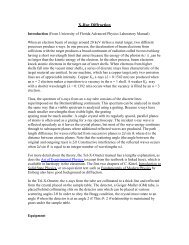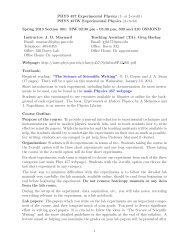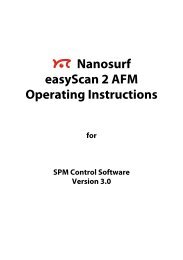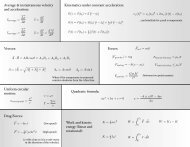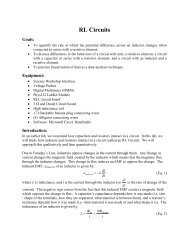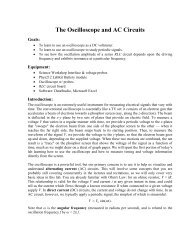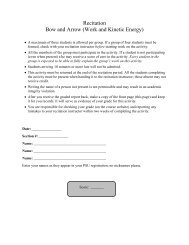Static Electricity (Lab 01)
Static Electricity (Lab 01)
Static Electricity (Lab 01)
You also want an ePaper? Increase the reach of your titles
YUMPU automatically turns print PDFs into web optimized ePapers that Google loves.
To facilitate the analysis of the data, and to acclimatize you to using common software tools for<br />
this task, we have provided a spreadsheet with the necessary calculations (e.g. Eqs. 4 and 5)<br />
already provided. Take this opportunity to open the “<strong>Static</strong>_<strong>Electricity</strong>.xls” spreadsheet and enter<br />
block<br />
mirror<br />
your measurements for d, X<br />
0<br />
, and X<br />
0<br />
in the spaces provided. Thoroughly read the<br />
directions below on how to perform the experiment (Steps 6 through 11), and then collect your<br />
data in the Excel spreadsheet.<br />
6. Rub your PVC pipe vigorously with the rabbit fur provided to charge the pipe.<br />
7. Charge the block-mounted ball by induction. To do so, first move the block and ball away<br />
from the Coulomb’s Law apparatus. Bring the charged PVC pipe near, but not touching the<br />
block-mounted ball, to within a few centimeters distance. Touch the block-mounted ball with<br />
your finger. Remove your finger from the ball and then remove the PVC pipe from the<br />
vicinity of the ball. The block-mounted ball has now been charged by induction.<br />
8. Slide the block and ball back into the groove in the Coulomb’s Law apparatus (being careful<br />
to not let the ball come into contact with any surface.)<br />
9. Slowly move the block-mounted ball into the apparatus until you see the suspended ball<br />
swing toward it, touch it, and then rapidly swing away. At this point, both the block-mounted<br />
ball and the suspended ball are charged. Move the block-mounted ball 0.5 cm back away<br />
from this position.<br />
10. Slide the block farther into the apparatus as far as you can (but not so far as to push the<br />
block-mounted ball into the suspended ball again; they should still be separated by some<br />
distance.)<br />
11. Humidity in the air and stray air currents will gradually discharge your spheres, so it best to<br />
work quickly. Using the Excel spreadsheet provided, record the positions of the block and the<br />
suspended ball as you slide the block in 2- or 3-mm increments back out of the apparatus.<br />
Take at least 10 or so readings.<br />
Once you have collected your data, proceed with the analysis by answering the following<br />
questions and providing graphs of your data where requested.



